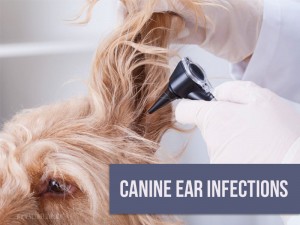
Canine ear infections

Unfortunately ear infections are common in dogs and although dogs with long or hairy ears such as Cocker Spaniels, Miniature Poodles or Old English Sheepdogs seem to be more susceptible, ear infections can affect any breed. Other predisposing factors include anatomical issues such as stenotic ear canals and increased moisture inside the ears of dogs that spend a lot of time in the water.
This condition is easy to spot since dogs suffering from this type of infection will look very uncomfortable, and will frequently scratch their ears and shake their heads. As time goes by the dog's ear becomes inflamed and painful. It is also common to observe an occasional black or yellowish discharge and an unpleasant smell coming from their ears. Many dogs will try to avoid having anyone touching their ears and they can even become aggressive.
Ear infections can be caused by several different causes such as parasites (e.g. ear mites), foreign bodies (e.g. grass seeds), polyps, bacterial infections, yeast infections, allergies, food hypersensitivity and even tumours.
It is recommended to keep an eye on your pet's ears to detect any abnormalities early and if you realise your dog is showing any of these signs take him or her to the vet as soon as possible. Your vet will need to check your dog's ears and the treatment will depend on what is causing the infection.
Quite often the treatment will include ear drops and tablets that owners must administrate to their pets at home. The ear drops must be carefully administered or else your dog will easily get rid of it just by shaking its head.
The dog's external ear canal is "L" shaped and ends in the dog's eardrum. To successfully apply the medication pull your dog's ear flap straight up and hold it with one hand. Apply the drops into the vertical part of the ear canal and hold it up until the medication runs down the dog's ear canal.
Place one finger and you thumb at the base of the ear flap and gently massage the ear canal until you hear a squishing sound, which will indicate that the medication has gone further into the ear canal. After this stage you can let your dog shake its head.
Keep an eye on your pet's ears. Early detection and adequate treatment will save your beloved pet from a lot of discomfort and pain.
Would you like to know more about dogs? Check our Canine Courses:
Canine courses
Published: 10 Nov 2015
Read the previous article: Cat Flu

